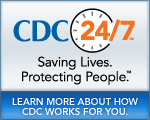MMWR
Morbidity and Mortality Weekly Report
Synopsis for February 28, 2008
There is no MMWR telebriefing scheduled for:
February 28, 2008
Human Rabies — Alberta, Canada, 2007
PRESS CONTACT: CDC
Division of Media Relations
(404) 639-3286
Rabies is a fatal but easily preventable disease. There is no established effective therapy after the onset of illness. Underestimation of the importance of the exposure can lead to a fatal outcome. Persons bitten by a bat should immediately 1) wash the wound thoroughly with soap and water; 2) capture the animal, if this can be done safely (i.e., by avoiding direct contact with the animal) or call local animal control services for assistance and submit the animal for diagnostic testing; 3) report the incident to relevant public health officials; and 4) see a physician for evaluation regarding the need for PEP. On April 26, 2007, a 73 year old man from Alberta, Canada, died from encephalitis after 9 weeks in an intensive care unit (ICU). The infection was caused by a rabies virus variant associated with silver-haired bats. He was bitten by a bat on his left shoulder while sleeping at home. He perceived the bite and killed the bat, but was unaware of the risk of rabies acquisition. Thus, he did not seek medical attention and did not send the bat for diagnostic testing. Rabies is an acute progressive fatal viral disease with no established effective therapy after the onset of illness. The disease is easily prevented if a person receives prompt and properly instituted post-exposure prophylaxis. An experimental approach to treat human rabies requires early diagnosis; therefore, rabies should be included in the differential diagnosis of any unexplained acute progressive viral encephalitis.
Perceived Insufficient Rest or Sleep — Four States, 2006
PRESS CONTACT: CDC
National Center for Chronic Disease Prevention and Health Promotion
Office of Communications
(770) 488-5131
More studies and data are needed to determine the prevalence and national impact of insufficient rest or sleep on adults. The National Sleep Foundation recommends seven to nine hours of sleep each night for adults. Some strategies to achieve a good night sleep include avoiding exercise and stimulants before bedtime, sleeping in a quiet and dark room, avoiding going to bed on a full or empty stomach, and relaxing before going to bed (I.e., meditation, soothing music, etc.). Individuals concerned about chronic sleep loss should consult their physician for a sleep disorder assessment and possible treatment. A new study that analyzes 2006 Behavioral Risk Factor Surveillance data collected from four states a€” Delaware, Hawaii, New York, and Rhode Island a€” found that only about one in three adults (29.6 percent) reported no days of insufficient rest or sleep in the past 30-days. However, one in 10 (10.1 percent) reported insufficient rest or sleep every day during the past month. The study, Perceived Insufficient Rest or Sleep a€” Four States, 2006, also found that nearly a quarter (24.8 percent) of adults unable to work were more likely to experience insufficient rest or sleep. An estimated 50-70 million Americans suffer from chronic sleep and wakefulness disorders. Sleep disorders and sleep loss have been associated with mental distress, depression, anxiety, obesity, hypertension, diabetes, high cholesterol and certain risk behaviors including cigarette smoking, physical inactivity and heavy drinking.
####
- Historical Document: February 28, 2008
- Content source: Office of Enterprise Communication
- Notice: Links to non-governmental sites do not necessarily represent the views of the CDC.
View Press Releases in
Get e-mail updates
To receive e-mail updates about this page, enter your
e-mail address:
Contact Us:
- Centers for Disease Control and Prevention
1600 Clifton Rd
Atlanta, GA 30333 - 800-CDC-INFO
(800-232-4636)
TTY: (888) 232-6348 - Contact CDC-INFO


